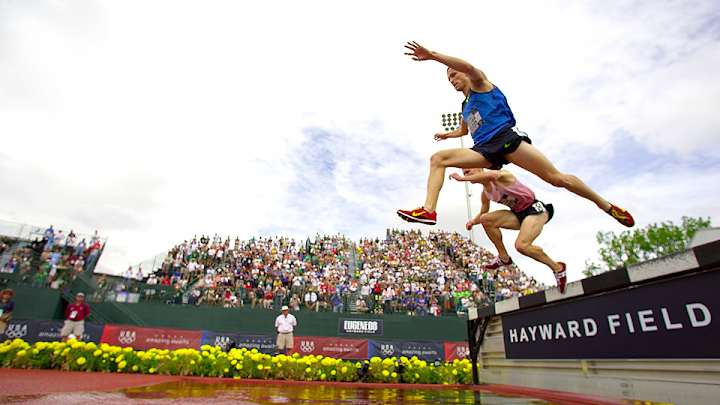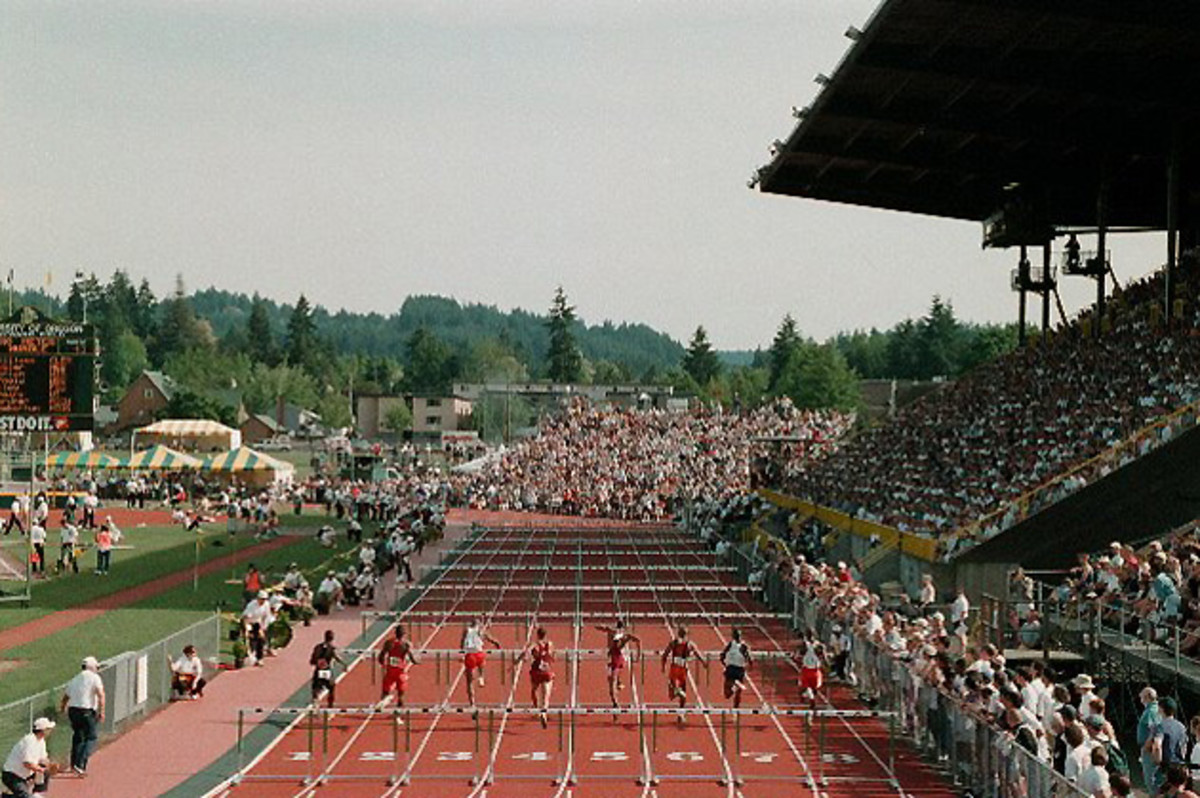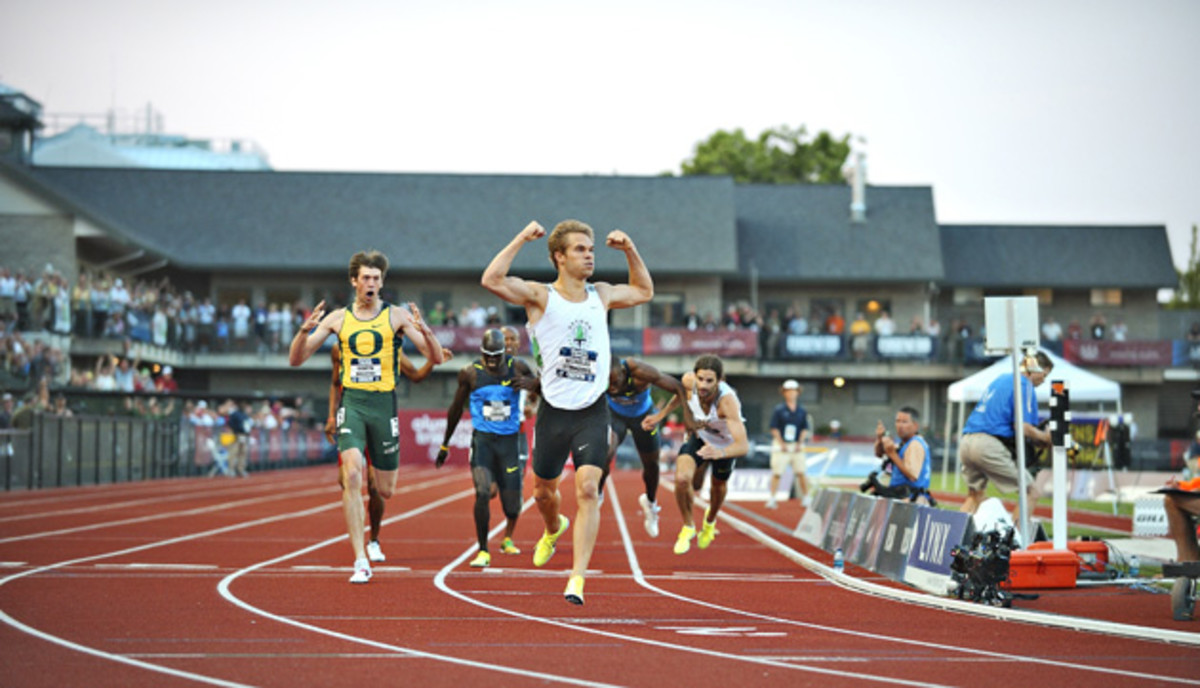TrackTown dreams big: Eugene's bid for the 2019 track and field worlds

A track and field story: In the summer of 2011, the sport’s 13th world championships took place in Daegu, South Korea, an industrial city of more than 2.5 million wedged into a deep valley in the southeastern corner of the country. It was not an entirely unpleasant setting—an endless riot of neon signs and six-lane commercial boulevards, bordered on its distant boundaries by lush, green hillsides that seemed to rise from nowhere. As with many international sporting events, there was a vaguely Lost In Translation feel to every day, but on the scale of one-to-Sochi, it was just fine.
My 2014 Sportsman nominee: Meb Keflezighi
was neither the first nor the last instance of this phenomenon.
The relevance of this? Sometime next Tuesday in the principality of Monaco, the 27 members of the IAAF commission, the governing body for international track and field, will vote to determine the location for the 2019 world championships. Three cities are under consideration: Barcelona, Spain; Doha, Qatar; and Eugene, Oregon. As with all sports and political events involving multiple participants, there is considerable handicapping underway as to which of the three locations will emerge victorious. Opinions differ, but there seems to be a consensus on one thing: Eugene is an outsider in this group. There’s plenty of reason for this mindset. Barcelona is a major European center of commerce and tourism with a spectacular athletic infrastructure (including a breathtaking track stadium on an urban mountaintop) and a long history of hosting international athletic competitions, including the 1992 Summer Olympics. Doha, already selected (controversially) as the host of the 2022 soccer World Cup, has a stunning array of facilities and hotels, all of which seem to have been built yesterday. Barcelona has a population of 1.6 million, Doha 1.3 million.

interprets its own sport’s place on the globe, and in the United States in particular.
Vin Lananna, the longtime coach (most recently at Oregon) and track and field overlord who heads the Eugene bid, eschews the underdog status. “I don’t see it that way,’’ says Lananna. “We are a different option from Barcelona and Doha. What do you want? That’s the decision the commission will make.’’
OK. What does the commission want? There have been 14 world championships and two future sites chosen—Beijing in 2015 and London in 2017. Of those 16 past and future sites, 11 are in Europe, four in Asia and one—Edmonton in 2001—in North America (the U.S. and Stanford University bid for the worlds in both 1999 and 2001 failed on both occasions). The smallest of the 16 cities to host the worlds was Goteborg, Sweden (pop: 541,000) in 1995. Helsinki (pop. 615,000) has hosted twice, most recently in 2005; no city with a population smaller than 2.5 million has hosted since. In short: The worlds have gone generally and increasingly to giant European and Asian cities. Those cities have an almost endless supply of very nice hotels and restaurants, which is almost certainly of greater concern to bureaucrats than to athletes.
Grand slam part of the journey for NYC Marathon winner Tatyana McFadden
, Edmonton and Paris-St. Denis (2003; big stadium, but suburban setting) were all sensational.
(*Disclaimer: All theories put forth in this piece of writing are under the assumption that no shenanigans are taking place in this bidding process. That no royal families, "local businessmen," or wealthy footwear and apparel companies are passing thick envelopes to any IAAF Commission members to influence their voting. That no commission members are currying favor with their brethren by casting a favorable vote. This could, of course, be a naïve position, because such irregularities have arisen in the past.)
Eugene and Lananna are taking their bid in an entirely different direction. From a practical standpoint, they are promising plenty of new hotel rooms. That’s great, but I’m still betting a voting commission member inclined to such thinking might lean toward that 2,500-square foot suite in Doha over the Eugene Hilton. Eugene can’t win a hotel fight. Lananna is also promising an expansion of Hayward Field to at least 30,000 seats, many of them permanent (the Hayward renovation will take place whether Eugene gets the worlds or not). They are promising an athletes’ village on the campus of the University of Oregon, from which competitors can walk to the stadium and warm-up track, mitigating the need for a complex and sometimes unreliable transportation system. All wonderful, but none of it at the heart of Eugene’s bid.
“This is the basis of our bid: It’s important to us,’’ says Lananna. “This is what we do here. We do track and field. We will bring an authenticity to the event.’’

likes to say, “We’re twenty-four, seven, three-sixty-five.’’ Eugene is so track-centric that it’s a little odd, in a cute sort of way. But what’s indisputable is that for four decades—with a few highs and lows—if somebody has put a major track and field competition in Hayward Field, the stands have been largely filled with passionate, knowledgeable fans. The 2008 and 2012 Olympic Trials were positively electric. Those events were held in a stadium expanded with temporary seating to a capacity just north of 25,000. Whether Eugene can deliver a capacity crowd of 32,000 every day for nine days for the world championships is a fair question. I wouldn’t bet against it.
The alternatives? Barcelona’s Olympic Stadium (again, but worth repeating: Breathtaking) seats just under 56,000. History suggests that the worlds in a major city will have trouble filling such a big facility and even more trouble generating citywide buzz. Doha’s Khalifa International Stadium seats 40,000 and it’s a beautiful, modern facility. But let’s address Doha. Putting aside the reported human rights violations in building facilities for the 2022 World Cup (not that such things should be put aside), Doha is proposing dates for the track worlds of late September and early October. At this point, average daily temperatures will have dropped into the high 90s. Nice for running 5ks and 10ks. Even at night, temperatures are in the low 80s. Moreover, the U.S. is a vital television market and we all know the U.S. television sports calendar is just wide open in late September and early October.
Now, the elephant in the room. The United States is, by any metric, far and away the most successful track and field nation on the planet. In those 14 editions of the worlds, U.S. athletes have won 300 medals. Russia is second with 168. The U.S.A.’s 138 gold medals are more than the second, third and fourth nations (Russia, Germany and Kenya) combined. In the Olympic Games, U.S. athletes have won 332 gold medals in track and field, more than the next nine countries combined. There are plenty of reasons for this: Population, money, a thriving high school and college system. (Some would argue doping. Nonsense. Track and field has long had a doping problem, but if U.S. athletes are caught more often, it’s largely because U.S. athletes are tested more often).
The upshot of all this is that without the United States, track and field is barely a sport at all. To have contested 14 world championships without coming to the U.S. is unconscionable. It’s like scheduling skiing’s annual World Cup with no races in Austria.
It’s no secret that track and field is struggling for mainstream visibility and funding in the United States. Too few athletes are designated as stars and made wealthy and too many are funded at the poverty level. I’m not sure how much a world championships in Eugene or even an Olympic Games in 2024 would change that. Sports viewing has become vigorously compartmentalized, excepting the NFL and college football. Almost every sport is a niche sport. Track and Field is one of those niche sports, and we’re never going back to the 1920s or the 1960s or whenever it was that track was more important than the NBA. (As to corollary to this, I have no patience for people who use track’s waning mainstream popularity in the U.S. as an argument against putting the Worlds here. Track’s mainstream popularity is waning everywhere, except when Usain Bolt is running).
But the IAAF must understand that it needs to give American track and field every opportunity to flourish, even if that only slows the bleeding. Think of it as a thank-you note for a century of dominance and support. Barcelona is storied. Doha is shiny and new. Eugene is the right place.
